Exploring Dubai's New Tallest Landmark: Insights and Impact
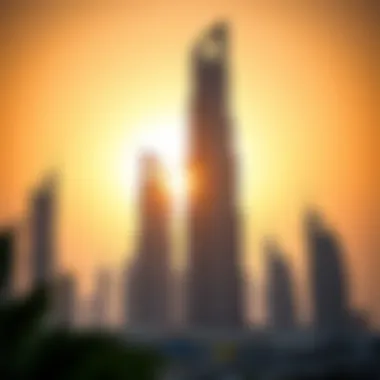
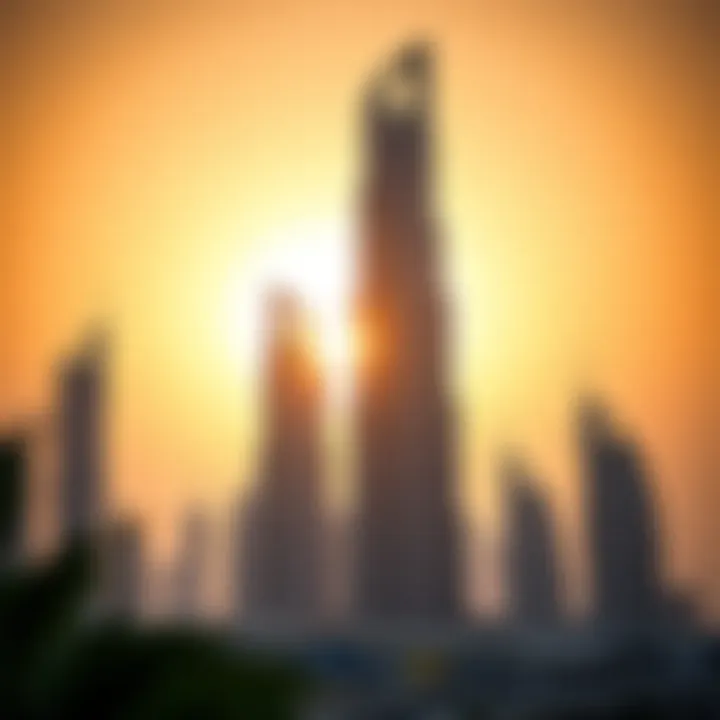
Intro
Dubai’s skyline has long been a canvas for architectural ingenuity, constantly evolving to accommodate aspirations that are as lofty as the buildings themselves. With the anticipated arrival of the tallest building, the city is set to adorn itself with yet another crowning jewel. This monumental structure signifies more than just a height; it represents the relentless pursuit of modernity that defines Dubai.
The new tower stands not just as a physical entity but also as a beacon for investors, homebuyers, and enthusiasts. Its presence signals a shift in the architectural landscape, pushing the limits of engineering and design. In this article, we will explore the implications of this building on the real estate market, the economic factors at play, and the future neighborhoods expected to rise in its shadows.
Market Trends
Current Real Estate Market Overview
Dubai’s real estate market has been a whirlwind of fluctuations. Despite global uncertainties, the city has shown remarkable resilience. The completion of the tallest building is likely to usher in a fresh wave of interest among investors.
Recent data reveals an increase in demand for luxury properties, particularly in regions surrounding this new high-rise. Properties that once languished on the market are now gaining attention, as buyers perceive added value in proximity to such pertinent landmarks. Consequently, prices in neighborhoods like Downtown Dubai and Dubai Marina have seen an uptick, with many anticipating even more growth post-completion.
Emerging Neighborhoods and Investment Hotspots
As the new tallest building reshapes the skyline, areas close to it are expected to develop into desirable locales. Neighborhoods such as Al Wasl and Jumeirah Gardens are ripe for investment, providing modern amenities and lifestyle options that align well with this architectural marvel.
Here are some factors contributing to the rise of these areas:
- Accessibility: Improved transportation links and infrastructure developments are in the pipeline, making these neighborhoods highly attractive.
- Lifestyle Offerings: With more recreational spaces, shopping facilities, and cultural attractions emerging, these areas will cater to a broader demographic.
- Community Integration: There's a push towards creating integrated communities that foster interaction and engagement amongst residents.
This blend of characteristics makes emerging areas around the tallest building ideal for both residential and commercial investments.
"With the tallest building standing proud, we expect a wave of new developments that will further redefine Dubai's residential landscape."
Buying and Selling Process
Step-by-Step Guide for Homebuyers
Navigating the real estate market can be daunting, especially with a major development on the scene. For homebuyers, the following steps can streamline the process:
- Research: Leverage online resources like Dubai Land Department to understand market trends.
- Financial Planning: Assess your budget, keeping in mind additional costs like registration fees or maintenance.
- Engage an Agent: A skilled real estate agent can provide invaluable insights and access to exclusive listings in emerging areas.
- Visit Properties: Take the time to physically visit properties. Virtual tours are helpful, but being there gives a clearer picture.
- Make an Offer: Once a suitable property is found, act swiftly to make an offer, especially in a competitive market.
- Finalize the Purchase: Ensure all paperwork is done and legal requirements are met.
Tips for Sellers to Maximize Property Value
Selling a property near the pinnacle of Dubai provides a unique opportunity. Sellers looking to maximize their property values can consider these strategies:
- Enhance Curb Appeal: First impressions matter. Simple landscaping improvements or a fresh coat of paint can make a big difference.
- Home Staging: Proper staging can help potential buyers envision themselves in the space, often leading to faster sales.
- Highlight Location Benefits: Emphasize the advantages of living near the tallest building, such as lifestyle enhancements or investment prospects.
- Be Flexible with Showings: Allowing easy access for potential buyers can significantly increase interest.
Prelude to Dubai's Architectural Ambitions
Dubai has long dazzled the world with its extraordinary feats of architecture, a journey that speaks volumes about its ambitions. As the city continues to evolve, its skyline transforms in tandem, showcasing a bold commitment to pushing the boundaries of design and engineering. In examining the latest pinnacle of Dubai's architectural prowess, it’s crucial to comprehend the vital significance of these developments, both in terms of global standards and local pride.
The Evolution of Skyscrapers in Dubai
The roots of Dubai’s ambition in skyscraper construction date back to the rise of the Burj Al Arab, which opened its doors in 1999, quickly establishing a benchmark for luxury and design. Over the years, including iconic structures like the Burj Khalifa, the tallest building in the world, Dubai has taken great strides.
The architectural scene here is akin to an artist's canvas; each new height represents an aspiration and a vision of what the city could potentially achieve. The evolution has been rapid and transformative. From the first high-rises that touched the skyline to today's advanced architectural feats, each building narrates a story of innovation and ambition.
In recent years, the combination of technology and creativity has given birth to designs that wouldn’t just populate skylines, but also redefine the very idea of living in an urban space. A myriad of structures use cutting-edge technology, materials, and sustainability principles, setting examples not just for other cities in the region, but also for global urban development.
Significance of the Tallest Building
The emergence of the tallest building is more than a structural milestone; it encapsulates dreams, economic aspirations, and cultural identifiers of Dubai. Such a height doesn’t merely dominate the skyline; it commands attention from all corners of the world. People are curious. Investors are interested. Tourists are drawn like moths to a flame.
"The tallest buildings are not just about height; they symbolize what a city stands for."
This monumental structure is a beacon, demonstrating Dubai’s continuous evolution as a significant global city that is not afraid to dream big. Its symbolism stretches far beyond the concrete and steel; it is a testament to human ability to overcome challenges and innovate relentlessly.


In a more practical context, the tallest building acts as a catalyst for economic growth. It enhances the urban landscape, often leading to increased tourism, boosted business districts, and elevated property values. The new pinnacle offers space that can accommodate various functions, from luxury living to commercial spaces. Thus, the structure generates diverse opportunities for different stakeholders in Dubai's economy.
By deepening our understanding of the significance of the tallest building in relation to Dubai's ambitions, we recognize how this architectural wonder stands as a metaphor for the emirate’s relentless pursuit of excellence. Whether you’re an investor looking to capitalize on the boom or a resident witnessing the transformation, this landmark holds stories and opportunities worth exploring.
Design and Architectural Features
Exploring the design and architectural features of Dubai’s tallest building provides a glimpse into the confluence of art, technology, and ambition. Every curve and angle is a testament to human creativity and engineering prowess. The significance of these features cannot be overstated; they are fundamental not only to the aesthetic appeal of the structure but also contribute to functionality and sustainability. As we delve into the inspirational aspects, choice of materials, and sustainability initiatives, we unearth the meticulous planning that goes into creating a building that aims to redefine boundaries.
Inspiration Behind the Design
The inspiration for the new pinnacle of Dubai's skyline stems from the rich tapestry of local culture, history, and nature. Architects often draw from their surroundings, and in this case, they sought to reflect the allure and dynamism of the desert landscape. The smooth, flowing lines of the building mimic the shape of sand dunes, while also echoing the sails of traditional Dhow boats, a beloved symbol of the area's maritime heritage.
Incorporating Islamic design elements, such as intricate geometries and patterns, links the modern structure to the past, creating not just a building but a narrative that echoes through time. This connection to culture enhances its significance, transforming a mere edifice into a landmark of national pride.
Materials and Technologies Used
The selection of materials plays a pivotal role in the structure's identity. High-strength concrete and steel composites are at the forefront, offering durability and resilience against Dubai's harsh climate. Each layer is meticulously crafted, ensuring that the building can withstand the unforgiving heat while optimizing energy efficiency.
Advanced technologies, such as 3D scanning and Building Information Modeling (BIM), played integral roles during the design and construction phases. These technologies facilitated accuracy and precision, allowing teams to foresee and mitigate potential challenges. Moreover, consider the incorporation of smart building systems that regulate energy consumption efficiently—sensors to adjust lighting based on the sun's position, for instance.
"Innovation in materials and construction techniques sets the foundation for future advancements in architecture."
Sustainability Initiatives
Sustainability is not merely an afterthought; it’s woven into the fabric of the design from the get-go. The building incorporates renewable energy solutions like solar panels and wind turbines. These solutions generate a significant portion of the energy used, thus reducing the carbon footprint.
Water conservation measures have also been implemented, including greywater recycling systems that allow for the reuse of water in irrigation. Natural ventilation strategies cut down on energy costs by maintaining comfortable temperatures without heavy reliance on air conditioning. The goal is not just sustainability for today but paving a way for future developments that harmonize with environmental needs.
In summary, the design and architectural features of Dubai’s tallest building encompass a holistic approach that marries tradition with innovation. From cultural inspirations and advanced materials to a deep commitment to sustainability, every aspect plays a significant role in reshaping not only the skyline but also the future of architectural endeavors globally.
Engineering Marvels: Construction Challenges
The construction of the highest building in Dubai epitomizes the phrase "shooting for the stars." This section delves into the distinctive challenges that engineers faced and how they became solutions in their own right. The engineering feats involved in this project truly define what it means to push the boundaries of modern construction, showcasing the resilience and innovation required in tackling such monumental tasks.
Foundation and Structural Integrity
Establishing a robust foundation is the bedrock of any skyscraper, particularly one towering above its surroundings. In the case of Dubai's newest architectural wonder, engineers confronted unique geological compulsions. The site is situated on the edge of the Persian Gulf, meaning soil conditions vary dramatically across the landscape.
To counteract potential ground shifting and ensure structural integrity, extensive soil testing was performed. Special piling techniques were employed, allowing for deep foundations that can withstand both the immense weight of the building and potential seismic events. The bored piles, installed to a depth of around 60 meters, serve as anchors, translating the building's enormous load into the more stable strata beneath.
Apart from the foundation, engineers prioritized the entire building's structural framework. The core design plays a crucial role, with a central mass that assists in stabilizing the structure against wind loads. It’s like a spine, ensuring that the overall integrity withstands both the elements and the passage of time.
"The foundation acts as a lifeline, distributing the weight and marrying the architectural vision with geological reality."
Innovative Construction Techniques
When you delve into the realm of skyscraper construction, the methods adopted can be as fascinating as the buildings themselves. In Dubai, a number of innovative techniques disrupted traditional construction paradigms. One is the advanced use of 3D modeling technology, allowing engineers to visualize structural components before they were built. This level of foresight reduces errors and streamlines the entire construction process.
Moreover, the actual assembly of the building utilized a bottom-up approach, rather than going traditional top-down. This tactic involved constructing essential floors while subsequent levels were still being completed. As sections rose, cranes became integral in shifting materials to ever-higher elevations. This method proved essential for ensuring the pace of construction did not lag behind, given the ambitious timeline.
BIM (Building Information Modeling) also played a notable role. This system led to refined project management and material handling, reducing waste—an important consideration in today’s environmentally conscious climate. This holistic view of the construction process allowed for better predictions and adjustments on site, ensuring that the project remained on track.
Notably, the construction utilized high-performance materials, enhancing acoustics and energy efficiency. This choice supports both sustainability initiatives and residents' comfort, marrying functionality with elegance.
In summary, the construction challenges faced during the development of Dubai's latest architectural marvel reveal the astounding ingenuity and dedication of engineers. From building strong foundations to utilizing state-of-the-art construction techniques, every aspect contributes to the creation of a thread that ties together Dubai's aspirations and its striking skyline.
Cultural and Economic Impact
The construction of the highest building in Dubai resonates far beyond the realm of mere architecture; it serves as a pivotal agent for cultural and economic change. Understanding the multifaceted influence of this monumental structure provides a clearer picture of its significance to Dubai and its global status. Not only does it symbolize ambition and modernity, but it also appertains considerable economic benefits and urban transformations, that's worth diving into.
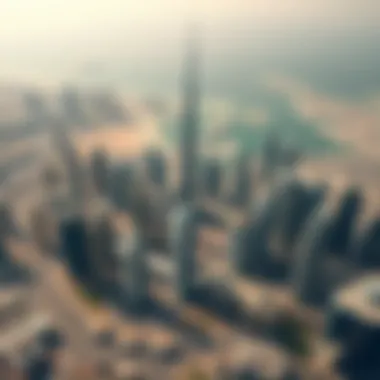
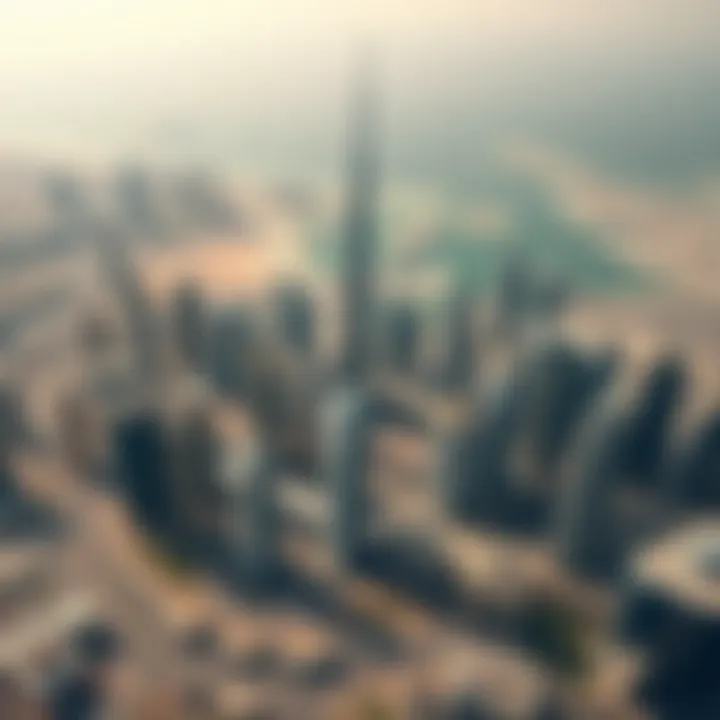
Influence on Urban Development
The emergence of any new skyscraper invariably shapes its surroundings, and the tallest building in Dubai is no exception. As an intricate part of urban development, this towering structure acts as a catalyst for complementary projects, invigorating the overall vision of the city. The skyline is not merely adorned but transformed, enhancing aesthetic appeal and functionality alike.
- Increased Land Value: Adjacent properties usually witness a rise in land value, which could be tied to heightened interest from business players and potential buyers.
- Infrastructure Upgrades: Such impressive growth often leads to improvements in public infrastructure, including transport and utilities, further amplifying the area's attractiveness.
- Integration of Public Spaces: Major projects often pave the way for revitalized green spaces and communal areas, contributing to the quality of life for residents.
In essence, the new skyscraper is part of a broader narrative that speaks to Dubai's strategic plans for urban excellence. Investments are flowing into the city's infrastructure, leading to improvements that benefit everyone involved, from residents to investors.
Boost to Tourism and Local Economy
Tourism, an essential component of Dubai's economy, stands to gain immensely from the construction of this landmark. The building offers an iconic draw, inviting tourists not just to gaze at its grandeur but to explore what Dubai has to offer.
- Attracting Global Tourists: Tourists worldwide flock in droves to see the newest addition to Dubai's skyline. The opportunity to experience the view from the top can persuade many to visit.
- Economic Spillover Effects: Increased foot traffic can generate revenue for surrounding businesses, including hotels, restaurants, and retail shops. Visitors often seek complementary experiences, such as guided tours or entertainment, many of which flourish in response to the new attraction.
- Employment Opportunities: The uptick in tourism creates jobs, from hospitality to retail, offering locals a chance to engage in Dubai's bustling economy.
"Tourism doesn’t just fill hotel rooms; it invigorates local businesses and plays an integral part in diversifying the economy."
In summary, the cultural and economic implications of this towering achievement are immense. Along with architectural brilliance, it paves the way for urban improvements and economic flourishing. Understanding this dual impact aids potential investors and stakeholders in making informed decisions as they consider the new dynamics of the Dubai market. The journey of growth and development continues and places a spotlight on Dubai as a model for other cities to study and emulate.
Real Estate Trends Following the Construction
The construction of the tallest building in Dubai is not just an architectural feat; it signifies a tipping point for the real estate landscape in the region. Understanding the real estate trends following this monumental construction sheds light on how such developments can transform property markets, even beyond the physical shadow of the skyscraper itself.
As the tallest building stands tall, with its sleek lines and shimmering glass facade, it offers not just a space to gaze upon but sets the stage for a myriad of economic possibilities. Investors and buyers need to recognize that real estate is often driven by perceptions, and a high-profile development can attract interest like moths to a flame.
One of the most immediate impacts tends to be on property values. With a prestigious new benchmark in place, areas surrounding the building often see a surge in demand. Tenants, homeowners, and investors flock to these coveted locales, eager for a slice of the high-flying lifestyle and status that comes with proximity to such iconic structures. Consequently, existing properties in these areas may experience a dramatic increase in market value, providing lucrative returns for those who had the foresight to buy ahead of the curve.
Another aspect of this trend is the ripple effect on nearby neighborhoods. New infrastructure—like improved transport links and additional amenities—often follows the installation of a landmark building. This influx can change the dynamics in lesser-known areas, leading to a revival of previously dormant communities.
Impact on Property Values
The ripple effect on property values is one of the clearest demonstrations of how an architectural wonder can shift market dynamics. The new height achieved by Dubai's skyline does not just elevate the building itself, but also lifts surrounding properties in its wake. As people seek the prestige tied to living near such a landmark, developers and homeowners see a golden opportunity to capitalize.
- Attracting High-End Buyers: The presence of a top-tier building naturally draws affluent individuals searching for luxurious lifestyles. The demand for real estate in the vicinity can skyrocket, which can raise prices considerably.
- Enhanced Rental Potential: Properties in this framework of visibility become coveted rental spots. Owners can command premium rent prices when their properties are situated next to a world-renowned landmark.
- Long-Term Value Stability: As interest surges, property valuations in the surrounding areas become more stable, offering a reliable investment for landlords and property managers.
In essence, the tallest building serves as a catalyst, creating a new narrative for real estate in Dubai.
Investor Interests and Market Predictions
Following the construction of the tallest building, investor interests begin to shift as they seek out opportunities linked to this high-profile asset. This transition involves a complex interplay of optimism and strategic planning, and discerning investors tend to be acutely aware of emerging patterns in the market.
With the surge in interest surrounding the tallest building, the following trends emerge:
- Diverse Investment Options: Given the notoriety surrounding such landmarks, investors gravitate towards a variety of avenues. Beyond mere residential spaces, there is buzz around commercial properties, retail spaces, and hospitality developments that cater to tourists and local Elites alike.
- Speculative Trends: Predicting market trends becomes a hotbed of speculation as investors try to get the edge. The anticipation of rising property values often leads to increased competition among buyers who want to stake their claim early.
- Global Investments: The visibility of the tallest building brings an influx of foreign investment. Investors from around the globe look to leverage Dubai’s brand, incorporating it into their portfolios to attract international buyers and firms seeking to establish regional headquarters.
Comparative Analysis with Other Global Landmarks
Understanding the significance of a new architectural marvel in Dubai necessitates a nuanced comparative analysis with existing global landmarks. This perspective not only highlights Dubai’s ambitions but also showcases how the city stands in the ever-evolving landscape of modern architecture.
When looking at such comparisons, several key points need focus:
- Design Philosophy: Each landmark encapsulates the ethos of its era and culture, and comparing them reveals the distinct design philosophies at play.
- Height and Innovation: Just measuring height can be misleading. The underlying engineering techniques, materials, and technology often reveal more about a structure's significance.
- Cultural Impacts: Landmarks often reflect the values and aspirations of their host cities, contributing to their cultural identity while also attracting tourism and investment.
This analytical lens widens the narrative surrounding Dubai's new structure, positioning it not merely as another skyscraper, but as a pivotal achievement that interacts meaningfully with established global icons.
Comparison with Burj Khalifa
The Burj Khalifa, until recently, held the title of the tallest building in the world, and naturally, comparing this new structure with it incites interest. The Burj Khalifa is not just notable for its height but also for factors like the architectural aesthetic, sustainability practices, and the complex choreography of modern engineering that went into its design.
- Height Difference: While many anticipate this new building to surpass Burj Khalifa's impressive altitude, it's the surrounding amenities and functional aspects that will ultimately determine its standing.
- Structural Techniques: The engineering approach used in both buildings is vital. For instance, the Burj Khalifa utilized a buttressed core in its design, a technique potentially emulated or evolved by the new construction.
- Cultural Relevance: Both buildings symbolize Dubai's rise as a global hub. However, as the newer structure emerges, it could either enhance Burj Khalifa's legacy or redefine it.
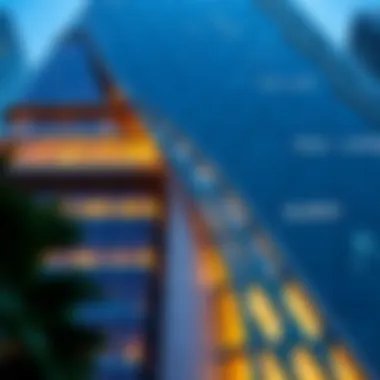
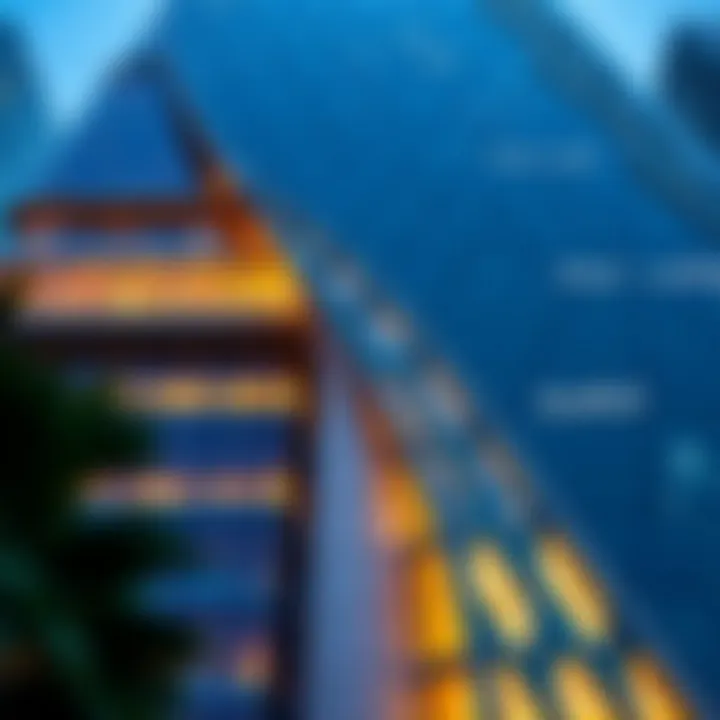
As we navigate this comparative spectrum, it’s crucial to understand how the attributes of both buildings resonate not only locally but with a broader audience seeking inspiration from this ambitious city.
Insights from Other Tall Buildings Worldwide
Looking beyond Dubai and even the Burj Khalifa, several global landmarks warrant focus. For instance, the Shanghai Tower in China showcases innovative energy-saving technologies, emphasizing sustainability in urban architecture. In comparison, the One World Trade Center in New York embodies resilience and a profound narrative of recovery after tragic events. What can Dubai learn from these international icons?
- Sustainable Design Practices: The Shanghai Tower is a beacon for integrating green technologies. Dubai could adopt insights on water conservation systems, energy-efficient designs, and materials that promote sustainability.
- Cultural Integration: Landmarks like the Sydney Opera House highlight the importance of melding architectural brilliance with cultural storytelling. An effective approach for Dubai would be incorporating elements that resonate culturally and historically.
- Role in Urban Sprawl: Structures such as the Petronas Towers in Kuala Lumpur reveal how skyscrapers can catalyze urban development. Understanding their influence on local growth patterns can provide a blueprint for integrating this new Dubai landmark within the city's architectural milieu.
As the dust settles over the completion of this new peak, its journey through the lens of comparative analysis will undoubtedly provide a richer understanding of what it means to be a part of a global architectural dialogue. For further reading on similar skyscrapers, resources like Wikipedia or Britannica offer in-depth exploration on these topics.
Future Prospects and Urban Planning
The significance of future prospects for urban planning in a rapidly developing metropolis like Dubai cannot be overstated. As the tallest building claims its spot on the skyline, it doesn't just become an architectural stand-out; it shapes the very fabric of the city's future. Investors, homebuyers, and urban planners alike must consider how this new marvel intertwines with ongoing development efforts.
Long-term Vision for Dubai’s Skyline
When envisioning the future of Dubai, one must appreciate the harmonious blend of innovation and culture. The tallest building serves as a pivotal marker, signaling not only ambitions but also the commitment towards futurism in design. The collective vision extends beyond mere aesthetics; it accounts for sustainable living, efficient transportation, and enhanced quality of life.
In practical terms, this vision translates to:
- Innovative Architecture: With new heights come new designs. The building will likely influence architectural trends globally, urging local architects to push their creative boundaries.
- A Hub for Investment: It’s anticipated that the structure will attract substantial international capital, drawn by the allure of novel living spaces, luxury shopping, and top-notch amenities.
- Integration of Smart Technologies: The use of cutting-edge technologies will be paramount, including smart energy systems and automated traffic control, aiming to streamline urban life.
The narrative isn't simply about height; it’s about what this new height represents—a city unwavering in its quest for modernism.
Integrating New Developments into City Infrastructure
Integrating the new developments with existing city infrastructure forms the backbone of Dubai's urban planning strategy. Modern skyscrapers like the tallest building don’t operate in isolation; they need a robust framework for traffic, transport, utilities, and green spaces.
Key considerations include:
- Transportation Links: Enhancing accessibility through the integration of public transport networks, such as having metro stations nearby, will facilitate smoother movement across the city.
- Utility Management: The increased demand for services necessitates strategic planning in water, waste management, and energy supplies. Ensuring that these systems are scalable is crucial.
- Green Spaces: Amidst concrete giants, the inclusion of parks or recreational areas caters to the community's well-being, balancing urban life with nature.
"Dubai’s future skyline is not just a reflection of its physical growth, but a statement on the aspirations of its people."
In summary, the future of Dubai’s skyline hinges on smart, innovative urban planning that prioritizes sustainable growth while remaining committed to economic vitality. For investors and stakeholders, recognizing these intertwined aspects will be vital in navigating the evolving landscape of this dynamic city.
For more detailed insights into Dubai’s urban development, visit resources like Wikipedia, or forums such as Reddit. The information shared by these communities offers profound insights into the city's ever-changing narrative.
As we move forward, keen awareness of how these trends develop will be essential for anyone aiming to be involved in Dubai’s thriving real estate market.
Culmination: Reflecting on an Architectural Milestone
As we draw the curtains on our exploration of Dubai's latest architectural landmark, it's clear that the implications of this towering structure extend far beyond mere aesthetics. It stands as a testament to human creativity, ingenuity, and ambition. This new pinnacle of architectural achievement not only shapes the skyline of Dubai but also embodies the city's relentless pursuit of progress. It prompts us to consider its significance in various domains—social, economic, and cultural.
Key Aspects to Consider
The significance of this building can be distilled into several core elements:
- Urban Identity: This structure redefines what it means to inhabit a modern metropolis. It symbolizes Dubai's identity as a global hub for business and innovation, attracting visitors and residents alike.
- Economic Catalyst: By drawing in tourists and investors, the building serves as an economic engine for the region. The resultant boost to the local economy cannot be understated, as it creates jobs and spurs development in adjacent sectors.
- Technological Achievement: This building is not merely another sharp peak in the skyline; it represents cutting-edge technology and construction methods that push the boundaries of what's possible. The engineering challenges overcome during its construction alone deserve commendation, and they set new standards for future projects.
"The new building exemplifies Dubai’s capacity for growth, reflecting a bold vision that aligns beautifully with its aspirations."
- Cultural Landmark: Beyond its structural magnificence, the building is poised to become a cultural icon. It invites exploration and storytelling, fostering a deeper connection among its occupants and visitors.
Looking Ahead
In contemplating the long-term impact, we are reminded that this building is just part of a larger narrative for Dubai. It lays the groundwork for future developments that will continue to enhance the city’s landscape while offering new avenues for human connection and economic opportunity. As urban planners and architects look ahead to further expansions, developments inspired by this new height will likely grow in tandem, influencing the trajectory of Dubai.
The Journey Ahead for Dubai
As we embark on this journey forward, it becomes paramount to recognize how the city will leverage this monumental achievement:
- Continued Urban Development: Future skyscrapers and buildings will likely draw inspiration from this iconic structure, leading to more innovation.
- Enhanced Infrastructure: Integration of transport systems and amenities to support the increased footfall in the area will be crucial for maintaining the city’s efficient functionality.
- Sustainability Focus: With growing global concerns about climate change, the city must ensure that subsequent projects prioritize sustainable practices in their design and execution.
It remains to be seen how this building, emblematic of Dubai's resilience and forward-thinking vision, will shape the urban landscape for generations to come.







